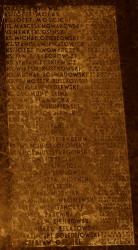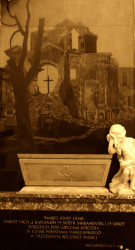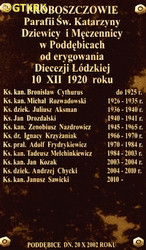Roman Catholic
St Sigismund parish
05-507 Słomczyn
85 Wiślana Str.
Konstancin deanery
Warsaw archdiocese, Poland
full list:
displayClick to display full list

searchClick to search full list by categories
wyświetlKliknij by wyświetlić pełną listę po polsku

szukajKliknij by przeszukać listę wg kategorii po polsku

Martyrology of the clergy — Poland
XX century (1914 – 1989)
personal data

surname
ROZWADOWSKI
forename(s)
Michael (pl. Michał)
function
diocesan priest
creed
Latin (Roman Catholic) Church RCmore on
en.wikipedia.org
[access: 2014.09.21]
diocese / province
Warsaw archdiocesemore on
en.wikipedia.org
[access: 2013.05.19]
Łódź diocesemore on
en.wikipedia.org
[access: 2013.05.19]
RC Military Ordinariate of Polandmore on
en.wikipedia.org
[access: 2014.12.20]
honorary titles
Rochettum et Mantolettum canonmore on
Rochettum et Mantolettum canon
(c. 1929)
date and place
of death
31.08.1944

Warsawtoday: Warsaw city pov., Masovia voiv., Poland
more on
en.wikipedia.org
[access: 2021.10.09]
details of death
After German and Russian invasion of Poland in 09.1939 and start of the World War II, during German occupation, chaplain to the resistance Home Army AK (part of Polish Clandestine State).
Perished during Warsaw Uprising of 1944, under the rubble of a bombed out by the Germans St Casimir church in Warsaw, along with 3 other priests, 34 nuns and over 1,000 civilians.
The church and its basement were transformed during the Uprising into a field hospital, run by the Medical Office of the Warsaw District of the Home Army AK (part of Polish Clandestine State) codename „Bakcyl”, part of the AK „North” Group. The area of the Old Town where the church is located had been under siege by the Germans for about two weeks.
On the night of 30‐31.08.1944, the insurgents made an unsuccessful attempt to break through to the Śródmieście district — it was the bloodiest battle during the Uprising. In retaliation, the Germans carried out particularly heavy bombings of the Old Town, including St Casimir church.
cause of death
shelling (bombardment)
perpetrators
Germans
sites and events
Warsaw (St Casimir church)Click to display the description, Warsaw UprisingClick to display the description, Ribbentrop‐MolotovClick to display the description, Pius XI's encyclicalsClick to display the description
date and place
of birth
27.09.1879

presbyter (holy orders)
ordination
1903

positions held
from 1938
rector — Warsawtoday: Warsaw city pov., Masovia voiv., Poland
more on
en.wikipedia.org
[access: 2021.10.09] ⋄ St Casimir RC church (of the Sisters of the Holy Sacrament) — also: prefect at schools
1935 – 1938
administrator — Jasieniectoday: Jasieniec gm., Grójec pov., Masovia voiv., Poland
more on
en.wikipedia.org
[access: 2022.08.05] ⋄ Descent of the Holy Spirit (Pentecost) RC church ⋄ St Rock the Confessor RC parish ⋄ Grójectoday: Grójec gm., Grójec pov., Masovia voiv., Poland
more on
en.wikipedia.org
[access: 2021.12.18] RC deanery
1925 – 1935
dean — Poddębicetoday: Poddębice gm., Poddębice pov., Łódź voiv., Poland
more on
en.wikipedia.org
[access: 2021.12.18] RC deanery
1925 – 1935
parish priest — Poddębicetoday: Poddębice gm., Poddębice pov., Łódź voiv., Poland
more on
en.wikipedia.org
[access: 2021.12.18] ⋄ St Catherine the Virgin and Martyr RC parish ⋄ Poddębicetoday: Poddębice gm., Poddębice pov., Łódź voiv., Poland
more on
en.wikipedia.org
[access: 2021.12.18] RC deanery
1910 – 1925
parish priest — Będkówtoday: Będków gm., Tomaszów Mazowiecki pov., Łódź voiv., Poland
more on
en.wikipedia.org
[access: 2021.03.16] ⋄ Nativity of the Blessed Virgin Mary RC parish ⋄ Brzeziny / Tomaszów Mazowieckideanery names/seats
today: Łódź voiv., Poland RC deanery
1908 – 1910
administrator — Kiczkitoday: Kiczki Drugie, Cegłów gm., Mińsk Mazowiecki pov., Masovia voiv., Poland
more on
en.wikipedia.org
[access: 2021.02.12] ⋄ St Anne the mother of Blessed Virgin Mary RC parish ⋄ Mińsk Mazowieckitoday: Mińsk Mazowiecki urban gm., Mińsk Mazowiecki pov., Masovia voiv., Poland
more on
en.wikipedia.org
[access: 2021.12.18] RC deanery
c. 1908
vicar — Warsawtoday: Warsaw city pov., Masovia voiv., Poland
more on
en.wikipedia.org
[access: 2021.10.09] ⋄ St Andrew the Apostle RC parish ⋄ St Charles Borromeo RC church ⋄ Warsaw‐in‐urbedeanery name
today: Warsaw city pov., Masovia voiv., Poland RC deanery
c. 1907
vicar — Warsawregion known as „Leszno” (around Leszno Str.)
today: Warsaw city pov., Masovia voiv., Poland
more on
en.wikipedia.org
[access: 2021.10.09] ⋄ Nativity of the Blessed Virgin Mary RC parish ⋄ Warsaw‐in‐urbedeanery name
today: Warsaw city pov., Masovia voiv., Poland RC deanery
c. 1905 – c. 1906
vicar — Mokotówtoday: district of Warsaw, Warsaw city pov., Masovia voiv., Poland
more on
en.wikipedia.org
[access: 2022.01.28] ⋄ Nativity of the Blessed Virgin Mary RC church ⋄ Warsaw‐in‐urbedeanery name
today: Warsaw city pov., Masovia voiv., Poland RC deanery
c. 1904
vicar — Mszczonówtoday: Mszczonów gm., Żyrardów pov., Masovia voiv., Poland
more on
en.wikipedia.org
[access: 2021.03.16] ⋄ St John the Baptist RC parish ⋄ Grodzisk Mazowieckitoday: Grodzisk Mazowiecki gm., Grodzisk Mazowiecki pov., Masovia voiv., Poland
more on
en.wikipedia.org
[access: 2021.04.01] RC deanery
c. 1898 – 1903
student — Warsawtoday: Warsaw city pov., Masovia voiv., Poland
more on
en.wikipedia.org
[access: 2021.10.09] ⋄ philosophy and theology, Metropolitan Theological Seminary
others related
in death
ARCHUTOWSKIClick to display biography Joseph, BAREJKAClick to display biography Catherine (Sr Mary Gertrude of the Holiest Heart of Jesus), BORKEMClick to display biography Louise (Sr Mary Antonina of the Holy Ghost), HRYNASZKIEWICZClick to display biography Leonard Victor, KARCZClick to display biography Hedwig Magdalene (Sr Mary Joachima of the Blessed Sacrament), KARCZEWSKAClick to display biography Sophia (Sr Mary Rose of the Blessed Sacrament), KILAŃSKAClick to display biography Catherine (Sr Mary Benita of the Holiest Heart of Jesus), KOPERSKAClick to display biography Apolonia Eleonor (Sr Mary Thomae of the Holy Trinity), KOWALSKAClick to display biography Victoria (Sr Mary Anne of the St Joseph's Protection), KRAKÓWClick to display biography Irene (Sr Hillary), KUŹMIŃSKAClick to display biography Margaret (Sr Mary Catherine of the All Saints), MARCZUKClick to display biography Helen (Sr Mary Bernarda of the Holiest Family), MATUSZCZAKClick to display biography Mary (Sr Mary Anselma of Immaculate Conception of the Blessed Virgin Mary), MAZERSKIClick to display biography John, MIĘTKOWSKAClick to display biography Mary (Sr Mary Cecilia of the Blessed Sacrament), NARUKClick to display biography Mary (Sr Mary Elisabeth of the Mother of God), OLĘDZKAClick to display biography Janet (Sr Mary Josefa of Immaculate Conception of the Blessed Virgin Mary), POGONOWSKAClick to display biography Irene Casimira (Sr Mary Vladislava of the Holiest Wounds of the Lord Jesus), POLAKOWSKAClick to display biography Marianne (Sr Mary Flavia of the Cross), PRZEMYSKAClick to display biography Angela (Sr Mary Stanislava of Divine Mercy), PRZYKOPClick to display biography Janet, PUCHAŁAClick to display biography Genevieve (Sr Mary Hedwig of the Blessed Sacrament), REJEWSKAClick to display biography Stephanie Wanda (Sr Mary Ignatia of the Lamb of God), RUDNICKAClick to display biography Caroline (Sr Mary Clementine of the Holiest Heart of Jesus), SCHMITZ de GROLLENBOURGClick to display biography Mary Josefa (Sr Mary Magdalene of the St Joseph's Protection), SIWEKClick to display biography Francesca (Sr Barbara), SŁOWACKAClick to display biography Sophia Catherine (Sr Mary Andrea of the Nativity of the Blessed Virgin Mary), SZKIŁONDŹClick to display biography Casimira (Sr Mary Modeste of the Cross), TOKARSKAClick to display biography Janet Bronislava (Sr Mary Agnes of Jesus), TOMASZEWSKAClick to display biography Aurelia (Sr Mary Therese of Jesus), TRYCClick to display biography Josefa (Sr Mary Aloysia of St Benedict), TURAKClick to display biography Rosalie (Sr Mary Ceslava of the St Joseph's Protection), ZALAZEKClick to display biography Josefa Marianne (Sr Mary Margaret of the Holiest Heart of Jesus), ZALEWSKAClick to display biography Laurence Laurentia (Sr Mary Augustina of the Blessed Sacrament), ZAŁUSKAClick to display biography Sophia Apolonia (Sr Mary Innocente of the Cross), ZDROJEWSKAClick to display biography Marianne (Sr Mary Claire of the Blessed Sacrament)
sites and events
descriptions
Warsaw (St Casimir church): On 31.08.1944 during Warsaw Uprising Germans run a bombing raid on St Casimir church at 2 Rynek Nowego Miasta (Old Town region), one of the most precious Baroque buildings in Poland, still under insurgents control. The bombs pierced through the basement ceiling that caved in. In the church Benedictine Nuns of Perpetual Adoration run a field hospital run to Medical Service of Warsaw District of Home Army AK (part of Polish Clandestine State) codename „Bakcyl” — in the AK „North” Group. Under rubble c. 1,000 civilians (mainly wounded patients), 4 Catholic priests and 34 nuns perished (one other nun died a few days later from exhaustion), as well as a few dozen Jews who survived Warsaw ghetto and went into hiding. The monastery and church complex were laid in ruins (destruction was estimated at 80‐90%). (more on: www.benedyktynki-sakramentki.orgClick to attempt to display webpage
[access: 2014.10.04])
Warsaw Uprising: Lasted from 01.08.1944 till 03.10.1944. Was an attempt to liberate Polish capital from occupying Germans by the Polish Clandestine State — a unique in the history of the world political structure on the territories occupied by the Germans, effectively governing clandestinely in Poland — and by fighting on its behalf underground military units, mainly of Home Army (former Armed Struggle Association ZWZ) and National Armed Forced (NSZ). At the same time Russians stopped on purpose the offensive on all front, halted on the other bank of Vistula river and watched calmly the annihilation of the city, refusing even the mid‐landing rights to the Allied planes carrying weapons and supplies to the insurgents from Italy. During the Uprising Germans murdered approx. 200,000 Poles, mainly civilians. Approx. 200 priests and nuns died in fighting or were murdered by the Germans, many in mass executions. (more on: en.wikipedia.orgClick to attempt to display webpage
[access: 2013.08.17])
Ribbentrop‐Molotov: Genocidal Russian‐German alliance pact between Russian leader Joseph Stalin and German leader Adolf Hitler signed on 23.08.1939 in Moscow by respective foreign ministers, Mr. Vyacheslav Molotov for Russia and Joachim von Ribbentrop for Germany. The pact sanctioned and was the direct cause of joint Russian and German invasion of Poland and the outbreak of the World War II in 09.1939. In a political sense, the pact was an attempt to restore the status quo ante before 1914, with one exception, namely the „commercial” exchange of the so‐called „Kingdom of Poland”, which in 1914 was part of the Russian Empire, fore Eastern Galicia (today's western Ukraine), in 1914 belonging to the Austro‐Hungarian Empire. Galicia, including Lviv, was to be taken over by the Russians, the „Kingdom of Poland” — under the name of the General Governorate — Germany. The resultant „war was one of the greatest calamities and dramas of humanity in history, for two atheistic and anti‐Christian ideologies — national and international socialism — rejected God and His fifth Decalogue commandment: Thou shall not kill!” (Abp Stanislav Gądecki, 01.09.2019). The decisions taken — backed up by the betrayal of the formal allies of Poland, France and Germany, which on 12.09.1939, at a joint conference in Abbeville, decided not to provide aid to attacked Poland and not to take military action against Germany (a clear breach of treaty obligations with Poland) — were on 28.09.1939 slightly altered and made more precise when a treaty on „German‐Russian boundaries and friendship” was agreed by the same murderous signatories. One of its findings was establishment of spheres of influence in Central and Eastern Europe and in consequence IV partition of Poland. In one of its secret annexes agreed, that: „the Signatories will not tolerate on its respective territories any Polish propaganda that affects the territory of the other Side. On their respective territories they will suppress all such propaganda and inform each other of the measures taken to accomplish it”. The agreements resulted in a series of meeting between two genocidal organization representing both sides — German Gestapo and Russian NKVD when coordination of efforts to exterminate Polish intelligentsia and Polish leading classes (in Germany called «Intelligenzaktion», in Russia took the form of Katyń massacres) where discussed. Resulted in deaths of hundreds of thousands of Polish intelligentsia, including thousands of priests presented here, and tens of millions of ordinary people,. The results of this Russian‐German pact lasted till 1989 and are still in evidence even today. (more on: en.wikipedia.orgClick to attempt to display webpage
[access: 2015.09.30])
Pius XI's encyclicals: Facing the creation of two totalitarian systems in Europe, which seemed to compete with each other, though there were more similarities than contradictions between them, Pope Pius XI issued in 03.1937 (within 5 days) two encyclicals. In the „Mit brennender Sorge” (Eng. „With Burning Concern”) published on 14.03.1938, condemned the national socialism prevailing in Germany. The Pope wrote: „Whoever, following the old Germanic‐pre‐Christian beliefs, puts various impersonal fate in the place of a personal God, denies the wisdom of God and Providence […], whoever exalts earthly values: race or nation, or state, or state system, representatives of state power or other fundamental values of human society, […] and makes them the highest standard of all values, including religious ones, and idolizes them, this one […] is far from true faith in God and from a worldview corresponding to such faith”. On 19.03.1937, published „Divini Redemptoris” (Eng. „Divine Redeemer”), in which criticized Russian communism, dialectical materialism and the class struggle theory. The Pope wrote: „Communism deprives man of freedom, and therefore the spiritual basis of all life norms. It deprives the human person of all his dignity and any moral support with which he could resist the onslaught of blind passions […] This is the new gospel that Bolshevik and godless communism preaches as a message of salvation and redemption of humanity”… Pius XI demanded that the established human law be subjected to the natural law of God , recommended the implementation of the ideal of a Christian state and society, and called on Catholics to resist. Two years later, National Socialist Germany and Communist Russia came together and started World War II. (more on: www.vatican.vaClick to attempt to display webpage
[access: 2023.05.28], www.vatican.vaClick to attempt to display webpage
[access: 2023.05.28])
sources
personal:
www.niedziela.plClick to attempt to display webpage
[access: 2013.05.19], grafik.rp.plClick to attempt to display webpage
[access: 2013.05.19], www.straty.plClick to attempt to display webpage
[access: 2015.04.18]
original images:
lodz-andrzejow.plClick to attempt to display webpage
[access: 2024.06.16]
LETTER to CUSTODIAN/ADMINISTRATOR
If you have an Email client on your communicator/computer — such as Mozilla Thunderbird, Windows Mail or Microsoft Outlook, described at WikipediaPatrz:
en.wikipedia.org, among others — try the link below, please:
LETTER to CUSTODIAN/ADMINISTRATORClick and try to call your own Email client
If however you do not run such a client or the above link is not active please send an email to the Custodian/Administrator using your account — in your customary email/correspondence engine — at the following address:

giving the following as the subject:
MARTYROLOGY: ROZWADOWSKI Michael
To return to the biography press below:
 Click to return to biography
Click to return to biography










